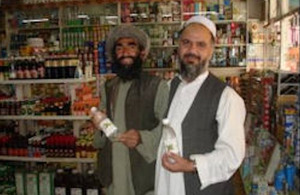DFID Research: Growing mint as an alternative to opium in Afghanistan.
Encouraging farmers in conflict areas to grown high-value crops such as mint has had a positive impact on the lives of many Afghan families.

Farmer (left) supplying mint water to satisfied shopkeeper. Picture: ICARDA
By adding value to mint and creating a strong market demand, ICARDA has transformed a kitchen-garden herb into a major source of income for hundreds of Afghan families.
Farmers in conflict-affected regions of Afghanistan are receiving support to grow crops other than opium. Opium poppies, which can earn up to 12 times the amount received for wheat per hectare, are the only source of income for about 1.7 million rural people in Afghanistan. But introduction of high-value crops such as mint has helped to change the lives of hundreds of Afghan families in 4 provinces (Helmand, Kabul, Kunduz and Nangarhar).
With support from DFID to the collaborative project on Research into Alternative Livelihoods (RALF), led by the International Center for Agricultural Research in the Dry Areas (ICARDA), 8 Mint Producer Associations, including 2 all-women associations, were provided with new equipment to produce and package mint water and mint oil. Farmers were also provided with cuttings of higher oil yielding varieties and trained in growing, drying, packaging and marketing of dried mint leaves, which yield up to 250% profit in the urban markets. Although the RALF pilot project ended in June 2008, development and training centres have been established at the Badam Bagh Research Station and at Kabul University.
Read the full version of this case study.
Key reference:
ICARDA, (2008) Cultivation of mint as a viable alternative livelihood in East and North East of Afghanistan, Final Report